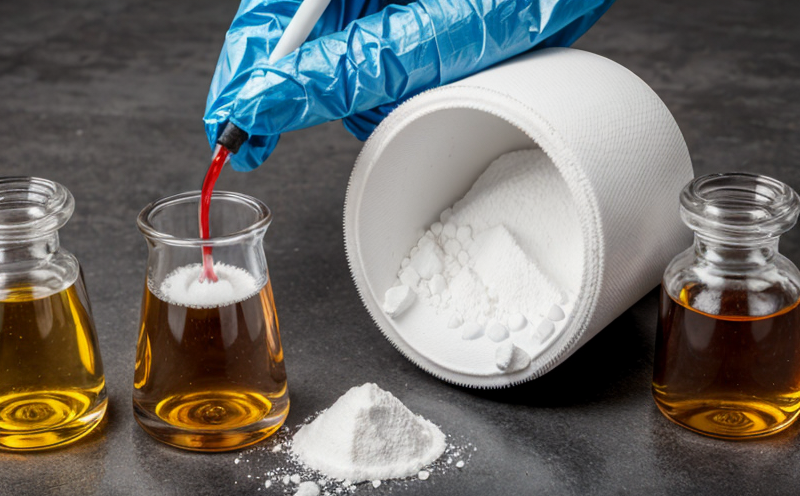ISO 14184 Formaldehyde Testing for Textiles
The ISO 14184 standard is a pivotal tool in ensuring textiles are safe from formaldehyde, a chemical used in the production of many synthetic fibers. This test is essential to prevent potential health risks associated with formaldehyde exposure, which can cause skin irritation and respiratory issues. Quality managers and compliance officers often rely on this testing for their products, especially when dealing with textiles that will be worn by consumers.
The standard applies to a wide range of textile materials used in clothing, home furnishings, and medical devices. Testing is particularly important for items like bedding, curtains, and garments, as these can release formaldehyde through off-gassing over time. This testing ensures that products meet regulatory requirements and safeguard the health and well-being of end-users.
Formaldehyde is a known allergen and carcinogen, making its presence in textiles a serious concern for both manufacturers and consumers. The ISO 14184 test method aims to measure the total amount of formaldehyde present on the surface and within the material. This includes free and bound formaldehyde, which can be released into the environment or absorbed by skin.
The testing process involves exposing a sample of the textile to specific conditions that simulate real-world scenarios, such as high humidity or heat. The sample is then analyzed using a spectrophotometric method, where the absorbance at 365 nm wavelength is measured. This allows for accurate quantification of formaldehyde in the textile.
This test is crucial for ensuring compliance with various international standards and regulations, including the European Union’s REACH Regulation and the California Proposition 65. Compliance officers must stay updated on these regulatory changes to ensure that their products are always safe and legal.
For R&D engineers working in the textile industry, this testing can provide valuable insights into how different materials interact with formaldehyde during production and processing. This information can be used to develop safer, more sustainable textiles that meet both performance and safety requirements.
In addition to consumer protection, this test is important for the environment. Textiles that contain high levels of formaldehyde may contribute to air pollution when they decompose or are incinerated. By ensuring compliance with ISO 14184, manufacturers can help reduce environmental impact by minimizing the release of harmful chemicals into the atmosphere.
The testing process is not only about measuring formaldehyde but also about understanding its behavior and potential risks. This knowledge can guide the development of alternative materials or treatments that are safer for both people and the planet.
Scope and Methodology
| Test Procedure | Description |
|---|---|
| Sample Preparation | The textile sample is cut into pieces of 10 cm x 10 cm, ensuring it represents the entire range of colors and patterns in the product. |
| Humidity Exposure | The samples are exposed to a controlled humidity environment for 24 hours at 95% relative humidity. |
| Spectrophotometric Measurement | The absorbance of the sample is measured using a spectrophotometer at 365 nm wavelength, which correlates directly with formaldehyde content. |
| Calculation of Results | The total amount of formaldehyde is calculated based on the spectrophotometric readings and compared against acceptable limits specified in ISO 14184. |
The testing process is designed to be rigorous, ensuring accurate results that can be relied upon by manufacturers, regulatory bodies, and consumers alike. The samples are carefully prepared to ensure they represent the full range of colors and patterns found in the product, which is crucial for obtaining meaningful data.
Once the samples have been exposed to high humidity conditions, they undergo spectrophotometric measurement using a specialized instrument that can detect even trace amounts of formaldehyde. This method allows for precise quantification of the chemical present on the textile surface and within the material itself.
The results are then calculated based on international standards, ensuring consistency and reliability across different laboratories. Compliance officers and quality managers can use these results to make informed decisions about product safety and regulatory compliance.
Quality and Reliability Assurance
- Strict adherence to ISO 14184:2017 ensures consistent and reliable results.
- Regular calibration of instruments ensures accurate measurements.
The laboratory adheres strictly to the ISO 14184 standard, which guarantees that all tests are conducted under controlled conditions. Regular calibration of instruments further enhances the reliability of the test results. This attention to detail is crucial for maintaining high standards of quality and ensuring that manufacturers can trust the testing process.
Environmental and Sustainability Contributions
- The reduction in formaldehyde emissions helps minimize air pollution when textiles decompose or are incinerated.
- Compliance with this standard contributes to a safer environment by ensuring that products meet strict safety and sustainability criteria.
By reducing the presence of formaldehyde, manufacturers can help protect both human health and the environment. This aligns with broader sustainability goals in industries such as textiles and home furnishings.





